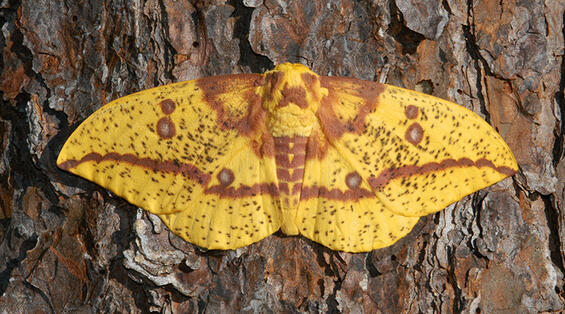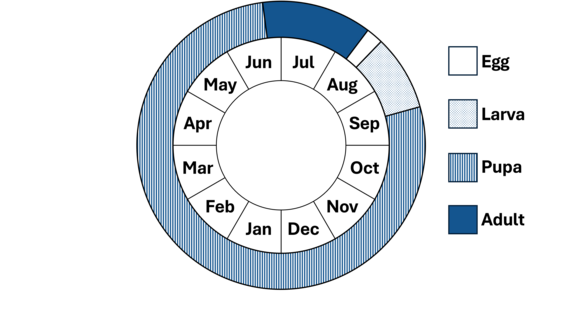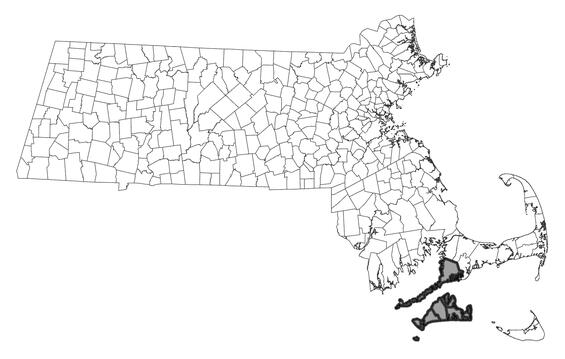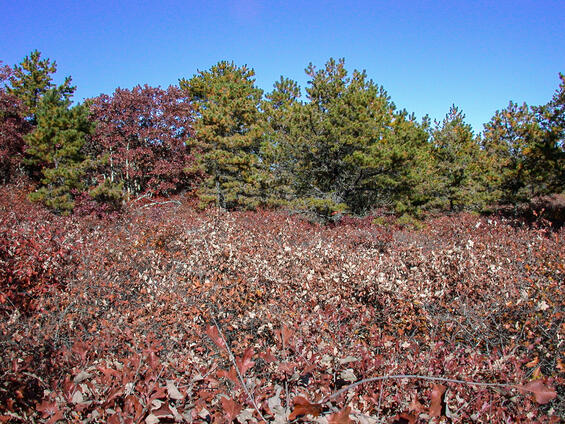- Scientific name: Eacles imperialis
- Species of Greatest Conservation Need (MA State Wildlife Action Plan)
- Threatened (MA Endangered Species Act)
Description

Imperial moth (Eacles imperialis)
The imperial moth (Eacles imperialis) is a large, colorful saturniid moth. The male has a forewing length of 47-59 mm (1.9-2.3 in), while the female is even larger, with a forewing length of 58-68 mm (2.3-2.7 in) (Tuskes et al. 1996). Both the forewing and the hind wing are bright yellow, with purplish to reddish-brown postmedial lines and a variable amount of shading of the same color. Compared to the female, the male often has more shading at the outer wing margins and in the basal area of the wings. Both sexes have a variable amount of dark brown to black speckling on both the forewing and hind wing. Also, both sexes have round, purplish to reddish-brown reniform and subreniform spots on the forewing, the center of each spot filled with gray; as well as a similar discal spot on the hind wing. The head, thorax, and abdomen are the same bright yellow as the wings, with purplish to reddish-brown patches on the thorax and transverse bands on the abdomen.
Life cycle and behavior

In Massachusetts, imperial moths emerge in late June and July, with peak emergence in late July; the flight period ends in early August (Goldstein 2010). Larvae feed almost exclusively on pitch pine (Pinus rigida) (Goldstein 2010), although there have been occasional reports of late instar larvae on oaks (Quercus spp.). Larvae are fully grown by September, at which time they burrow into the soil and pupate. The pupa overwinters.
Distribution and abundance
The imperial moth is widely distributed in eastern North America, from Massachusetts south to Florida, and west to Nebraska and Texas (Tuskes et al. 1996). It has declined dramatically in New England during the past 100 years, with the only surviving population in the region now restricted to Martha’s Vineyard, Massachusetts (Goldstein 2010). Occasionally, individuals that presumably originated from Martha’s Vineyard are found on the Elizabeth Islands or the nearby mainland.

Distribution in Massachusetts.
1999-2024
Based on records in the Natural Heritage Database.
Habitat
In Massachusetts, the imperial moth inhabits pitch pine-scrub oak barrens, pitch pine woodland, and pitch pine-oak woodland.
Healthy habitats are vital for supporting native wildlife and plants. Explore habitats and learn about conservation and restoration in Massachusetts.

Sandplain pitch pine-scrub oak barrens habitat for the imperial moth. Habitat managed by TNC at Medicine Lots Preserve.
Threats
The imperial moth is threatened by habitat loss and fire suppression in its disturbance-dependent habitats, in particular sandplain pitch pine-scrub oak barrens, pitch pine woodland, and pitch pine-oak woodland. Other potential threats include introduced generalist parasitoids, aerial insecticide spraying, and clear-cut timber harvest. The effect of a warming climate may not be detrimental to this species in Massachusetts; its range extends south to Florida, suggesting adaptation to warm temperatures.
Conservation
Land protection and habitat management are the primary conservation needs of the imperial moth in Massachusetts. In particular, sandplain pitch pine-scrub oak barrens, pitch pine woodland, and pitch pine-oak woodland should be conserved, restored, and managed to maintain habitat for this species and the entire suite of rare and threatened species dependent on such habitats.
Survey and monitoring
The distribution of the imperial moth in Massachusetts is well documented. The Martha’s Vineyard population of this species should be surveyed in each of its larger habitat areas across the island to document persistence at least once every 25 years; every 10 years is more desirable when practicable.
Management
Management of sandplain pitch pine-scrub oak barrens benefits a suite of rare and threatened species, and habitat condition should be monitored and management adapted as needed. For the imperial moth, pitch pine woodland and pitch pine-oak woodland habitat may also need management to maintain habitat quality.
Research needs
The natural history and conservation needs of the imperial moth are relatively well known. However, the future effects of a warming climate on this species are unpredictable and should be documented.
References
Goldstein, P.Z. 2010. Life history of the imperial moth Eacles imperialis (Drury) (Saturniidae: Ceratocampinae) in New England, U.S.A.: distribution, decline, and nutritional ecology of a relictual islandic population. Journal of Research on the Lepidoptera 42: 34-49.
Tuskes, P.M., J.P. Tuttle, and M.M. Collins. 1996. The Wild Silk Moths of North America: A Natural History of the Saturniidae of the United States and Canada. Cornell University Press, Ithaca, New York. 250 pp.
Contact
| Date published: | March 6, 2025 |
|---|